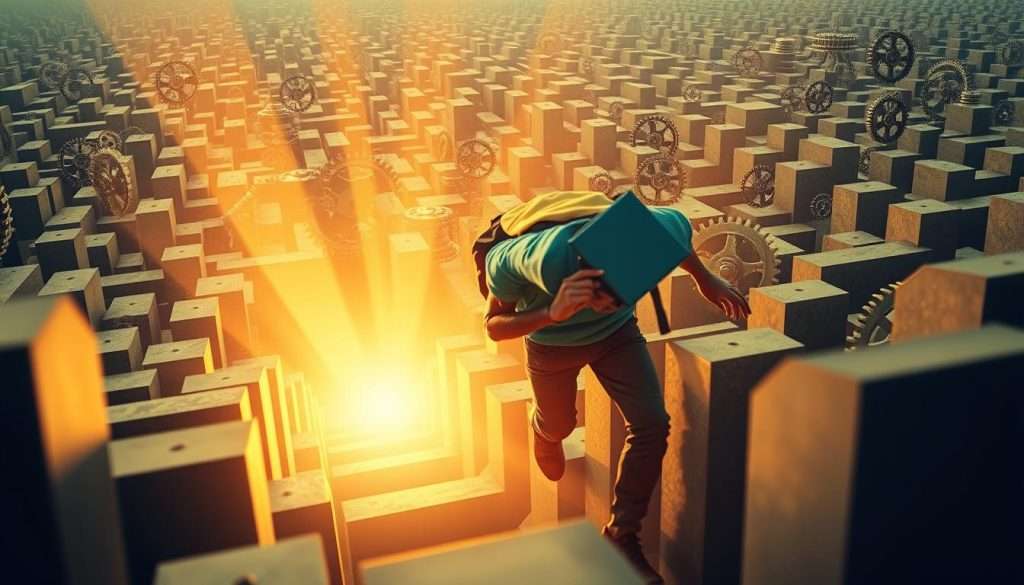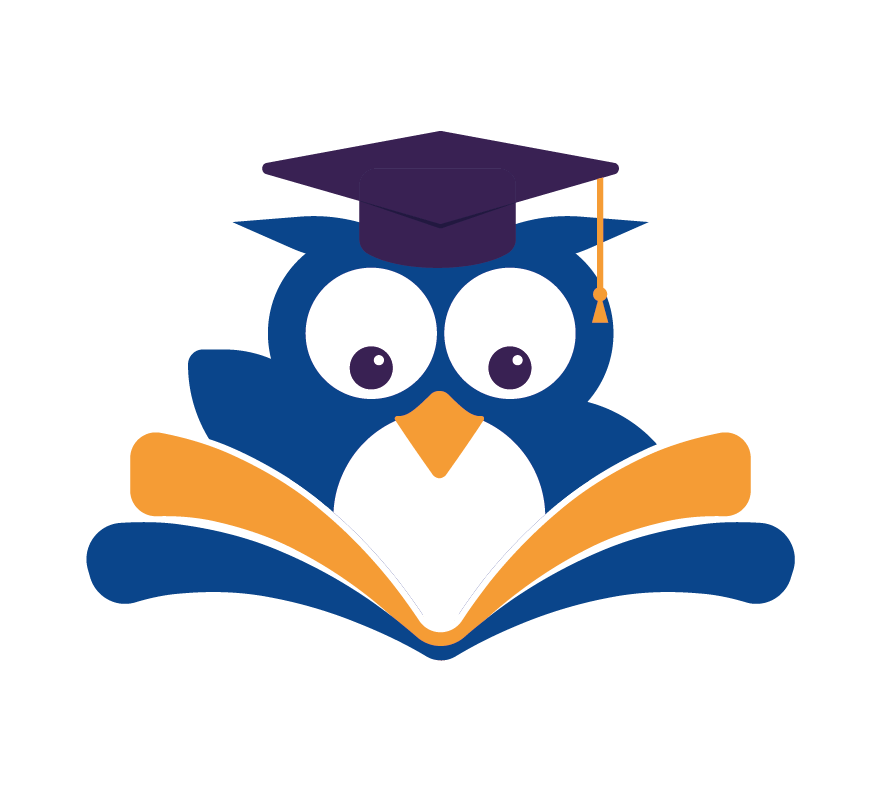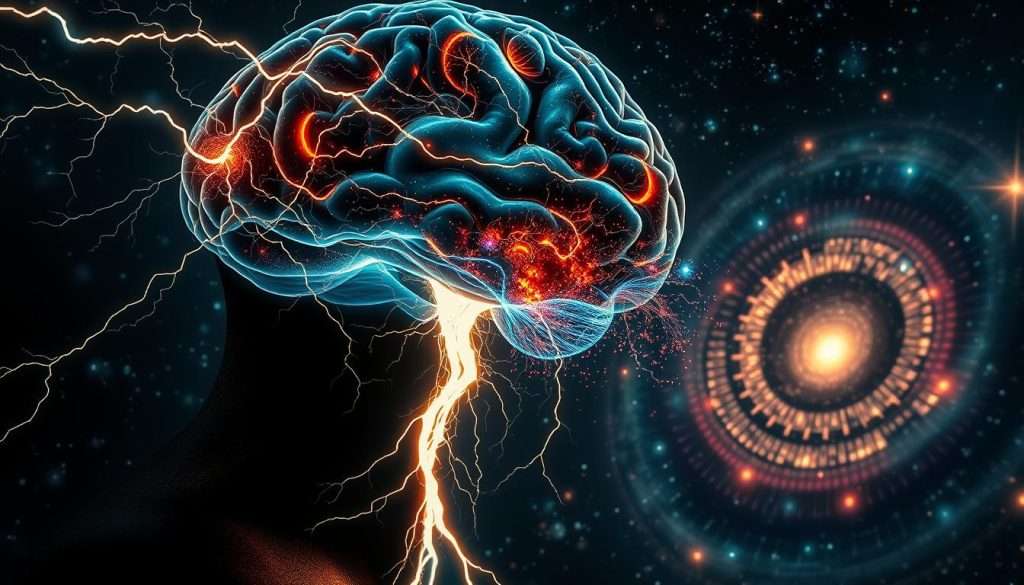I’m always searching for ways to learn new things quickly. Charlie Munger, Vice-Chairman of Berkshire Hathaway, once said, “Those who keep learning, will keep rising in life.” In today’s fast world, learning new skills fast is key.
We’re excited to share accelerated learning techniques to help you master new skills quickly. These strategies are backed by science. They make learning more efficient and effective, helping you reach your goals sooner.
Key Takeaways
- Discover the secrets to accelerated learning
- Learn how to stay motivated and focused
- Unlock the power of effective learning techniques
- Master new skills in a fraction of the time
- Achieve your goals faster with our proven strategies
The Science of Accelerated Learning
Learning faster starts with knowing how our brains handle new info. By using insights from cognitive psychology and neuroscience, we can learn better and faster.
How Your Brain Processes New Information
Our brains are great at learning new things. But, we can get even better with the right methods. Neuroplasticity, or the brain’s ability to make new connections, is key to learning.
The Role of Neuroplasticity in Learning
Neuroplasticity lets our brains change and adapt as we learn. This flexibility is essential for quick learning.
Attention and Memory Formation
Focus and making memories are vital for learning. Using methods that boost these can make us learn faster.
The Neurological Basis for Rapid Skill Acquisition
Learning quickly isn’t just about practicing. It’s about making our brains better at learning. Myelination, or the insulation of neural pathways, is important for this.
Myelination and Skill Development
Myelination makes signals travel faster in our brains. This directly helps us perform skills quickly and well.
The Learning Curve Explained
The learning curve shows how we get better with practice. Knowing this curve helps us learn smarter.
| Learning Technique | Description | Benefit |
|---|---|---|
| Spaced Repetition | Reviewing material at increasingly longer intervals | Improved long-term retention |
| Chunking | Breaking down complex information into smaller chunks | Easier to understand and remember |
| Myelination | Insulating neural pathways through practice | Faster skill execution |
By grasping the science of fast learning, we can improve our learning. We can use methods like spaced repetition, chunking, and practice to get better.
Preparing Your Mind for Lightning-Fast Learning
Rapid learning isn’t just about the techniques you use; it’s also about preparing your mind and environment. To master anything quickly, you need to set the foundation right.
Optimizing Your Learning Environment
Creating a conducive learning environment is crucial. Choose a quiet space without noise and visual clutter. This helps reduce cognitive load and keeps you focused on your goals.
The Growth Mindset: Your Secret Weapon
Adopting a growth mindset is vital for rapid learning. Believe that your abilities can be developed. This mindset makes you more resilient and helps you see learning as a journey, not a destination.
Physical Preparation: Sleep, Nutrition, and Exercise
Don’t underestimate the power of physical preparation in learning. Adequate sleep, proper nutrition, and regular exercise are key. They improve cognitive function, boost memory, and help you learn quickly and effectively.
The 80/20 Principle: Focus on What Matters Most
The 80/20 principle is a game-changer for learners. It helps you focus on the vital few things that really matter. This principle shows that about 80% of results come from 20% of efforts. In learning, a small part of what you learn can lead to most of your progress.
Identifying the Vital Few vs. the Trivial Many
To apply the 80/20 principle, you need to find the most critical information. Start by analyzing your learning goals and what knowledge or skills are essential. Ask yourself, “What are the most important concepts or tasks that will drive the greatest results?” By focusing on these vital few elements, you can avoid wasting time on non-essential details.
For example, if you’re learning a new language, the vital few might include common phrases, grammar rules, and vocabulary related to your interests. The trivial many could be obscure grammar exceptions or less common vocabulary.
Creating Learning Maps to Prioritize Knowledge
A learning map is a visual tool that helps you organize and prioritize your learning. It’s like a roadmap that guides you through the most important topics. To create a learning map, start by brainstorming key concepts related to your learning goal. Then, categorize them based on importance and relevance.
| Learning Topic | Importance Level | Relevance |
|---|---|---|
| Core Concepts | High | Directly related to the goal |
| Supporting Details | Medium | Provides additional context |
| Nice-to-Know Information | Low | Interesting but not crucial |
By using a learning map, you can efficiently allocate your time and energy to the most critical areas. This accelerates your learning process.
Chunking: Breaking Complex Skills into Manageable Parts
Chunking is a powerful technique that helps you learn like lightning by making complex information simpler. When we learn something new, our brains can get overwhelmed. Chunking breaks down this information into smaller, easier-to-handle parts.

The Psychology Behind Chunking
Our brains can only handle so much information at once. This is known as the “magical number seven, plus or minus two.” Chunking groups information into fewer, more meaningful chunks. This reduces cognitive overload and improves memory.
How to Deconstruct Any Skill Effectively
To use chunking well, first identify the main parts of the skill you want to learn. Ask yourself:
- What are the fundamental elements of this skill?
- How can I break down these elements into smaller, actionable steps?
- What are the critical tasks that will give me the most significant results?
By answering these questions, you can make a learning plan that focuses on one chunk at a time. This makes learning more manageable and less scary.
Sequencing Your Learning for Maximum Efficiency
The order in which you learn chunks of information matters a lot. Sequencing your learning means arranging these chunks in a logical order. This order should build on what you’ve learned before.
- Reinforce previously learned material
- Gradually increase complexity
- Provide a clear progression path
By breaking down complex skills into smaller parts and learning them in order, you can learn faster. This approach helps you reach your learning goals more efficiently.
Learn Like Lightning: Master Anything Faster with These Memory Techniques
Learning new skills fast is easier than you think. The right memory techniques can help a lot. They make it easier for our brains to remember and learn.
The Memory Palace Method
The Memory Palace Method, also known as the Method of Loci, is a great way to remember lots of information. You imagine a place you know well and link what you want to remember to spots in that place. It’s great for remembering lists, sequences, or complex data.
Spaced Repetition Systems
Spaced Repetition Systems (SRS) help you review material at the best time to remember it. By reviewing when you’re about to forget, SRS makes it stick in your memory. It’s perfect for learning languages and complex ideas.
Association and Visualization Techniques
Association and visualization are key for good memory techniques. By making mental images vivid and linking them to what you want to remember, you make it easier to recall.
Creating Memorable Mental Images
To make mental images memorable, make them vivid and unusual. The weirder the image, the more it will stick in your memory. For example, imagine each item on a list in a strange or exaggerated way.
Building Strong Neural Connections
Creating strong neural connections is key for remembering things long-term. It’s not just about memorizing; it’s about understanding and connecting different pieces of information. Summarizing in your own words or teaching it to someone else works well.
Here’s a comparison of the memory techniques discussed:
| Technique | Best For | Key Benefit |
|---|---|---|
| Memory Palace | Memorizing lists, sequences | High retention rate |
| Spaced Repetition | Language learning, complex concepts | Optimized review timing |
| Association/Visualization | General memorization | Improved recall |
“The art of memory is the art of attention.” – Samuel Johnson
Using these memory techniques in your learning can make you learn new skills fast and remember better.
Deliberate Practice: Quality Over Quantity
Mastering a new skill isn’t just about time. It’s about focused practice. Deliberate practice helps you improve specific skills. This method speeds up learning and leads to mastery faster.
The Difference Between Practice and Deliberate Practice
Not all practice is the same. Deliberate practice is focused and structured. It requires your full attention. For example, when learning a new language, focus on improving your pronunciation or mastering a tough grammar rule.
Designing Effective Practice Sessions
To use deliberate practice well, plan your sessions carefully. Identify what you want to improve. Then, break it down into smaller parts. For instance, practice a specific guitar chord progression in one session. Stay focused to make the most progress.
Feedback Loops: The Key to Rapid Improvement
Feedback is key in deliberate practice. It shows you what to work on next. Create a feedback loop to keep improving. This could be a coach, recording yourself, or apps that give instant feedback. Feedback helps you make targeted improvements and learn faster.
Leveraging Technology for Accelerated Learning
Technology has changed how we learn, making it faster to master new skills. The digital world is full of tools and resources to help us learn quicker.
Digital Tools and Apps for Faster Learning
Digital tools and apps have changed learning by making it more personal and sharing knowledge easily. Some top tools include:
- Spaced Repetition Software: Apps like Anki help you remember better by using smart algorithms.
- Note-Taking and Knowledge Management Tools: Evernote and Notion help you organize and connect your ideas.
- Learning Platforms and Courses: Sites like Coursera and Udemy offer courses on many subjects.
Online Resources and Communities
Online communities and resources are also key for fast learning. They offer chances to work together, get advice, and get feedback.
- Finding Expert Mentors and Guides: LinkedIn and forums can connect you with experts.
- Collaborative Learning Opportunities: Joining online forums, study groups, and projects can make learning better.
Overcoming Learning Plateaus and Obstacles
As you start your learning journey, you’ll face challenges. But with the right quick mastery strategies, you can get past them. Learning is a journey with ups and downs.

Recognizing and Breaking Through Plateaus
A learning plateau happens when you feel like you’re not making progress. To move forward, find out where you’re struggling and change how you learn. You might need more resources or a different practice routine.
Managing Information Overload
With so much information out there, it’s easy to feel lost. To handle this, focus on the most important information and break it down. Learn the key concepts first, then move on to harder topics.
Strategies for Maintaining Motivation
Keeping motivated is key to overcoming obstacles. Setting effective learning goals helps you stay on track.
Setting Effective Learning Goals
Make your goals specific, measurable, achievable, relevant, and time-bound (SMART). This keeps you focused and lets you see your progress.
Celebrating Small Wins
Don’t wait for the big win to celebrate. Celebrate small victories to keep your motivation up. By using these efficient learning tips, you’ll overcome learning hurdles and stay on course.
Applying Rapid Learning Techniques to Different Domains
Rapid learning techniques can change how we learn new things. They help us pick up new skills quickly. Whether it’s a new language, a professional skill, or improving in sports, these methods speed up the process.
Languages and Communication Skills
Speed learning methods make learning languages and communication skills faster. Spaced repetition and immersion are key. For example, apps that use spaced repetition can teach you new words and phrases quickly.
Technical and Professional Skills
For technical and professional skills, accelerated learning techniques like chunking and deliberate practice are crucial. Breaking down complex skills into smaller parts makes learning quicker. Focused practice on specific skills also speeds up learning.
Creative and Artistic Abilities
Creative and artistic skills also benefit from rapid learning. Techniques like association and visualization boost creativity. For instance, visualization can help you create new artistic works more easily.
Physical and Athletic Skills
Physical and athletic skills can also be improved with speed learning methods. Deliberate practice and breaking down movements into simpler parts speed up learning. Visualization can also enhance performance by mentally rehearsing skills before practicing them.
| Domain | Techniques | Benefits |
|---|---|---|
| Languages and Communication | Spaced Repetition, Immersion | Faster Vocabulary Acquisition |
| Technical and Professional Skills | Chunking, Deliberate Practice | Efficient Skill Acquisition |
| Creative and Artistic Abilities | Association, Visualization | Enhanced Creativity |
| Physical and Athletic Skills | Deliberate Practice, Visualization | Improved Performance |
Using these accelerated learning techniques across different areas helps you reach your goals faster and more effectively.
Conclusion: Your Roadmap to Becoming a Lightning-Fast Learner
We’ve looked at ways to learn like lightning: master anything faster. By using these efficient learning tips, you can speed up your learning. This will help you reach your goals sooner.
To learn quickly, practice regularly, stay persistent, and be patient. Use methods like chunking and deliberate practice. Also, make the most of technology to improve your learning.
Remember, the journey is as important as the destination. Keep yourself motivated and track your progress. Adjust your learning methods as you go. With the right mindset and strategies, you can reach your full potential.
Now it’s your turn to start. Apply these techniques today. Watch yourself become a lightning-fast learner!

